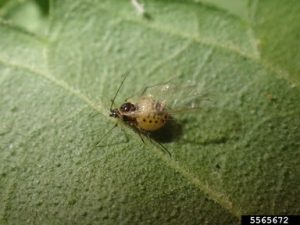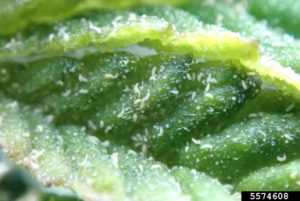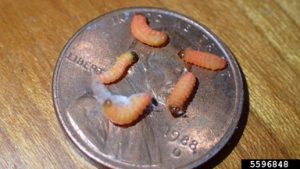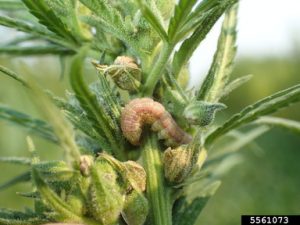
(This is the 10th installment in a series focused on cultivation planning for hemp and marijuana growers. The previous installment is available here.)
It’s no secret that many insects love cannabis, but research shows that four main pests do the majority of damage to outdoor cultivation.
According to Whitney Cranshaw, an entomology professor and extension specialist at Colorado State University, researchers identified 150 genera of arthropods – insects, mites and spiders – in hemp fields during field sampling during the 2016, 2017 and 2018 growing seasons in Colorado.
The overwhelming majority of those insects were not directly damaging those crops, Cranshaw said during an Advancing Hemp online event in May.
But four key pests stood out as the most damaging in outdoor cannabis production:
Researchers are still restricted from studying marijuana because of its federally illegal status, but because hemp and marijuana are so similar, many of the findings from hemp research can often be applied to marijuana crops.
Cannabis aphids
Cannabis aphids extract fluids from the plant through “precision feeding.” In high populations, they can cause a serious problem for crops.

A cannabis aphid. (Photo by Whitney Cranshaw, Colorado State University, via Bugwood.org)
“They also secrete a sticky fluid called honeydew, and if this gets on the buds, there may be issues with some fungal contamination growing on the sugary waste they produce,” Cranshaw said.
One big question is how cannabis aphids can survive between seasons in areas of the country with hard-freezing winters.
Aphids typically need to feed on live plants to reproduce asexually.
Late in the season – around the first week of September in Colorado, with declining daylengths – different sexual forms show up, male and female, to mate, produce eggs and lay eggs on the flowers and leaves. Those eggs stay dormant through the winter, Cranshaw said.
Cannabis aphids can survive outdoors on the debris of feral, hemp, wild volunteers, which produce seed. When the seed germinates the next spring, the newly hatched insects feed on it, Cranshaw said.
“If you clean up the volunteers, you will not allow this insect to survive between seasons,” Cranshaw said.
In indoor production, where cannabis aphids are particularly common, they can survive all year, as long as the daylength is long enough, he said.
Russet mites
Hemp russet mites are so small, “they make a spider mite look like an elephant,” Cranshaw said.

Hemp russet mites. (Photo by Whitney Cranshaw, Colorado State University, via Bugwood.org)
Because little is known about hemp russet mites, the insect is a current focus of research for Colorado State University’s entomology program.
Sometimes hemp varieties will curl at the base of the leaves when infested with high populations of russet mites, but other plants don’t have the same symptoms – and further, there are some cultivars that will curl more than others, Cranshaw said.
Cultivators can’t tell if they have russet mites just by looking for curling – they must look for the mites with hand tools and microscopes.
Because they’re so small, russet mites feed on the epidermal cells to kill the first top layer of the plant, but they can’t go down any further than that.
“But that can cause damage. They can cause that leaf roll on some cultivars, but more commonly, what I’ll see is a kind of a grayish cast – it just looks off because of epidermal damage.”
Russet mites will continue to move on to the newer growth and, ultimately, onto the buds, damaging the developing flower parts.
In a trial last year on the hemp cultivar Unicorn, Cranshaw’s research team used sulfur as a treatment.
“We got a yield response that was shocking,” he said.
“This hasn’t been figured out for CBD production, but for dry weight … 46% increase in yield from treating with sulfur. That treatment, by the way, is not yet registered but is on the way to being so.”
Eurasian hemp borers
The Eurasian hemp borer, which attacks cannabis flowers, has several generations in a season. It can be found in the stems in the first generation, which might be completed very early in the season by June and another generation completed by July.

Eurasian hemp borers. (Photo by Whitney Cranshaw, Colorado State University, via Bugwood.org)
“When they are in the stem, you might see wilting near that point where they’re inside, so if you see some wilting leaves, cut at that point and you might find the tunnels within,” Cranshaw said.
Later in the season, when flowers are in production, that tunneling might extend into the bud, which creates dead areas and damage, and can leave the plants vulnerable to other insects.
Eurasian hemp borers could also be a problem on hemp grown for seed. A study of the insect on wild hemp produced a 28% reduction in seed production, Cranshaw said.
Corn earworms
These insects cause the most damage, which is a problem for hemp or other outdoor cannabis produced for flower.
A well-known pest, corn earworms attack everything from corn and cotton to peppers and tomatoes.

A corn earworm. (Photo by Whitney Cranshaw, Colorado State University, via Bugwood.org)
Corn earworms lay eggs at night in sweet corn and field corn on the emerging tassels with green silks. Hemp and marijuana are most attractive to corn earworms when the plants start budding flowers.
“They’re not laying eggs on the leaves till you get flowers, and after the flowers have passed, it becomes no longer attractive,” Cranshaw said.
The young caterpillars don’t do much damage but once they molt and get bigger, the later stage insects can ream out the bud and bore through multiple buds during their lifespan.
“They will tunnel in from the side and do a lot of chewing, buds may be destroyed, and they also defecate and leave pellets (where) rot can come in,” Cranshaw said.
The Colorado State Hemp Insect Website has developed a management plan for this pest, which is adopted from managing corn earworms in organic sweet corn.
Pest-control options
Some products that are federally registered through the U.S. Environmental Protection Agency have listed hemp on the application label and might help with these key pests.
But because cannabis has been illegal for so long, many states developed their own policies on legal and prohibited pest-control products, both for hemp and state-legal marijuana crops.
Any pesticides allowed are typically food-crop-tolerance exempt and most are organic-certified, Cranshaw said.
But some states are stricter than others, so cultivators must confirm their market’s pesticide policy before purchase and use.
Laura Drotleff can be reached at [email protected]

